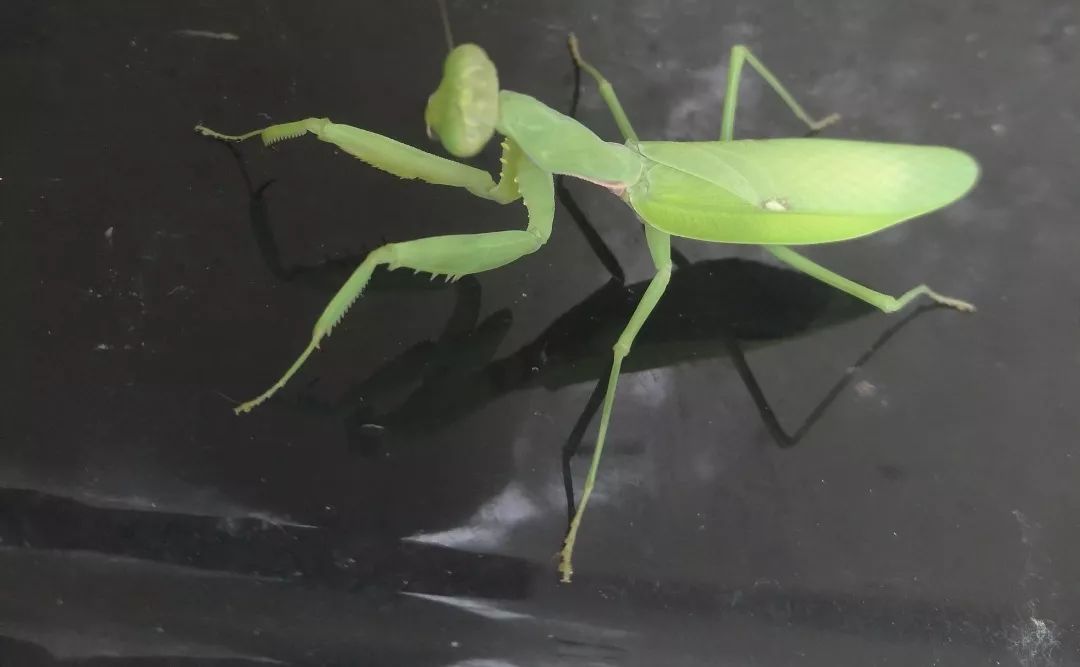
The males of the broad-bellied mantis are particularly great
For the next generation
They are willing to make great sacrifices
The wide-bellied mantis Hierodula patellifera (Serville) is also known as the broad-bellied mantis and the broad-bellied mantis. It is an insect of the animal kingdom, arthropod phylum, insect family, mantis, mantis family, and axe mantis. It is found in Japan, the Philippines and Indonesia. Domestic distribution in North China, Central China, East China, South China, Taiwan and so on.
Morphological characteristics: Females are 57–63 mm long. The male is 41–56 mm long. Body green (grass green and emerald green) or brown (purple brown and talk brown). Head triangle. Compound eyes are developed. The antennae are elongated and filamentous. The dorsal plate of the forethia is thick and short, long diamond-shaped, almost equal in length as the basal segment of the forefoot, significantly expanded at the transverse groove, finely toothed lateral margins, and smooth on both sides of the mediastinal groove in the anterior half, without small particles. The anterior thorax is extremely flattened and has 2 brown transverse bands at the base. There are 2 small gray-white dots on the mid-chest web. The keel of the forefoot basal segment has 3 yellow disc processes, the leg segment is thick, flattened laterally, and has fairly long small spines between the inner line and the inner and outer lines. The abdomen is wide. The forewings are very wide , the wings are longer than the abdomen , and there is a pale yellow wing spot at the femurs. The hindwings are of equal length to the forewings.
Oocysts: like a roof ridge
Ovate yellow, 3.8 mm long and 1.0 mm wide.
Nymphs are similar to adults, wingless, and begin to show wing buds at 5-6 years of age.
Oocysts
Nymph
Life history: The broad-bellied mantis overwinters on the trunk, branches or stones in the trunk, branches or stones of the sunshine for one generation, hatches in mid-May of the following year, feathers into adults in mid-August, and lays eggs in mid-September for the winter. It takes 16-19 days for the broad-bellied mantis to feather from adult to mating tail, and the female adult can lay eggs multiple times in her life, from tail to first spawn takes about 10 days, the first egg laying to the second spawn takes about 21 days, the second to the third spawn takes 26 days, and the egg laying ends in early December.
Life Habits: The broad-bellied mantis spends its life living mainly on shrubs and trees, rarely in grass. Nymphs and adults prey on a period of up to 4-5 months and can prey on a variety of pests. The 1st-2nd instar nymphs prey on 7 families, including homoptera, and adult and juvenile (ifthoptera) of the family Hymenoptera. After the 3rd instar, the number of predatory insects increases, and it can prey on adult and larvae of 8 species such as hemiptera, 5 families such as Coleoptera scarab, 5 families such as Hymenoptera tree beetles, 6 families such as Diptera flies, 2 families such as Orthoptera Antsko, and 20 families of Lepidoptera.
Male insects
Why great
Freshly picked
It is said that the male male of the broad-bellied mantis is great because it seems that the male is alive for love all his life, and the male after the tail will take the initiative to let the female adult eat it, of course, if it is not eaten, the average survival time of the male adult after the tail is only about 6 days.
The female adult will "with a pulse" while crossing the tail and turning back to eat the male, until the tail.
they
beneficial insects
It is a beneficial insect
Broad-bellied mantises are beneficial because their food is often an agricultural and forestry pest. In order to protect the mantis, Zhongshan Scenic Area pays attention to the scientific prevention and control of diseases and insect pests, and in recent years, the scenic spot has created mixed forests through the closure of mountains and afforestation, creating environmental conditions conducive to the habitat and reproduction of praying mantises and increasing its population. We also hope that the majority of tourists will also cherish beneficial insects, protect praying mantises, and strictly prohibit the purchase of egg blocks for medicinal purposes and other destructive behaviors.
Graphic | JuFeng
Edit | You Xingyu
Some of the images are from the web